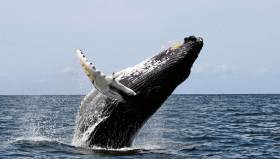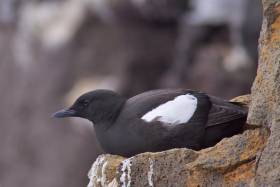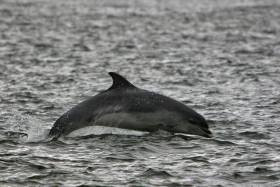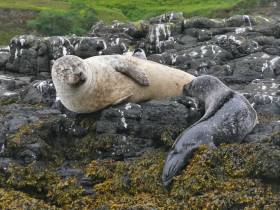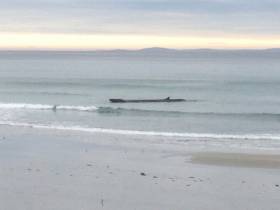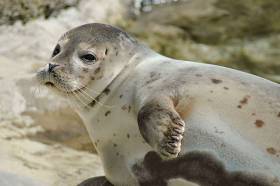Displaying items by tag: marine wildlife
Dolphins Rescued In Tarbert Stranding Drama
#MarineWildlife - The Irish Whale and Dolphin Group (IWDG) reports the good news of the rescue of two live common dolphins that stranded on a Co Kerry beach at the weekend.
IWDG volunteers found three dolphins at Tarbert on Sunday morning (8 January), one of which was already dead while the others were in shallow water, with one of them swimming into even lower waters upriver towards Tarbert village.
“We knew we had to come up with a plan as the area is surrounded with mudflats, and once the tide started to recede we would not be able to get access to or re-float the dolphin if it stranded again,” reported Joanne O’Brien.
That’s when Tarbert Rowing Club came to their aid with a small inflatable that allowed the volunteers to retrieve the bewildered dolphin and steer it in the right direction.
The IWDG has more on the story HERE.
Whale Watchers Claim First Irish Humpback Sighting Of 2017
#MarineWildlife - Whale watchers off the Sunny South East believed they’ve photographed Ireland’s first humpback whale sighting of 2017, as TheJournal.ie reports.
South Coast Charter Angling skipper Martin Colfer was out with photographer Myles Carroll yesterday (Wednesday 4 January) when they caught a glimpse of the tail fin of the 13-metre-long marine mammal as it slinked back under the surface.
In other Irish whale news, The Times says work has begun on removing the famous diplodocus skeleton replica from London’s Natural History Museum to make way for a blue whale found in Wexford more than a century ago.
As previously reported on Afloat.ie, the whale specimen has been in the museum’s collection since it washed up at Wexford Harbour in 1891, and will now take pride of place in the central that Dippy previously called home since 1905.
Meanwhile, the world’s oldest killer whale is presumed dead after researchers lost track of her movements some months ago, according to the Guardian.
Believed to be 105 years old, ‘Granny’ was the matriarch of a small and endangered group of orcas in Puget Sound, north of Seattle in the north-west United States.
“With regret we now consider her deceased,” researcher Ken Balcomb, who has tracked Granny and her fellow orcas over four decades.
The genetically unique population bares comparison with the distinctive orca pod that splits its time between Ireland and Scotland, and which has faced its own challenges in recent years.
Protections Called For Shannon Dolphins In North Kerry
#MarineWildlife - Conservationists want Tralee Bay and Brandon Bay in North Kerry to be declared a protected marine wildlife zone for bottlenose dolphins.
The call comes in the wake of new research by the Irish Whale Dolphin Group (IWDG) in tandem with the Shannon Dolphin and Wildlife Foundation, which has identified the vast majority of bottlenose dolphins in North Kerry as members of the Shannon Estuary group that has enjoyed Marine Protected Area status since 2000.
“We knew dolphins had been regularly observed in Brandon Bay,” said the IWDG’s Dr Simon Berrow of the new research, “but did not know which population they belonged to and had no idea they were as abundant and frequent as this study has shown.”
Stephanie Levesque, senior author of the study, added that the research identified “very high numbers of Shannon dolphins present during the summer months in Brandon and Tralee Bays.
“If further surveys were to be carried out at various times of the year, including collecting behavioural data, it could help us to better understand how they are using these habitats.”
Elsewhere on the West Coast, Galway Bay FM reports on efforts in Connemara to form local groups in Oughterard and Letterfrack which are designated for the protection of pearl mussels.
Black Guillemots & Ancient Clams Gain New Protections In Northern Ireland
#MarineWildlife - The RSPB has welcomed the announcement of new marine protected areas for Northern Ireland this week.
“The formal designation of four new marine protected areas will help protect a range of vulnerable species and habitats - ranging from black guillemots to ocean quahog and seagrass meadows,” the wildlife charity said in a statement.
Among the new Marine Conservation Zones (MCZs) announced by Storming is an area near Rathlin Island off Co Antrim that’s the first in the UK to be set aside for a seabird species, the amber-listed black guillemot.
The other new zones announced include seagrass meadows in Waterfoot, also in Co Antrim, and the fragile ecosystem for sea pens in Carlingford Lough.
Also included among the new MCZs is the territory of ocean quahogs in outer Belfast Lough.
According to The Irish News, these clams are thought to have been thriving in the waters near the city for over 200 years - and individual clams could live for hundreds more.
The Stormont announcement comes a year after the new zones were first proposed for public consultation, as previously reported on Afloat.ie.
New North Kerry Local Group For Dolphin Watchers
#MarineWildlife - The first meeting of the Irish Whale and Dolphin Group’s (IWDG) new local group for North Kerry takes place this Friday 9 December at the Tralee Bay Wetlands Centre from 7.30pm to 9pm.
All are welcome to the evening’s talk by biologist Dr Marie Louis on her work on bottlenose dolphins in Ireland and internationally, followed by a meeting on setting up the new group.
The North Kerry group’s main focus is to get local people out experiencing and recording cetaceans and collecting data for the IWDG, as well as increasing membership numbers. Contact [email protected] for more information.
In other news, Conal O’Flanagan has been appointed to the IWDG’s board of directors, replacing regular Celtic Mist helm Karl Grabe.
O’Flanagan joined the IWDG soon after its formation in 1999 and was the first co-ordinator of its Constant Effort Sighting Scheme. The resident of North Co Dublin has previously been a director on the board and served as group treasurer.
Irish Seals Are Cannibals? Research Shows Possible Link To Death Numbers
#MarineWildlife - Is cannibalism among seals to blame for deaths of the marine mammals recorded on Ireland’s shores?
That’s one reason suggested by researchers in the latest report from the Irish Seal Sanctuary’s seal death database, according to the Irish Examiner.
While further research is required, recent studies at UCD indicate that some injuries previously attributed to boat propellers may be consistent with attacks on younger seals by older bulls.
Fishing activity is also suspected in some of the more than 100 carcasses recorded in the two years before May 2016 — particularly over the winter months in Waterford and Wexford, though there is no confirmed connection to the concurrent inshore fishery.
The sanctuary’s database relies on public contributions, with the largest number of seal carcasses reported in Dublin, followed by Cork, Wexford and Waterford.
In related news, the Dublin InQuirer reports on the uneasy relationship between dog walkers on Bull Island and the reserve’s resident seal colonies, which conservationists argue are often disturbed by pets running loose.
Large Whale Stranding On Mayo Beach
#MarineWildlife - The Irish Whale and Dolphin Group (IWDG) received a report at the weekend of a large baleen whale struggling in the shallows at Cross Beach in north-west Co Mayo.
The 12-metre marine mammal, thought to be a sei whale or fin whale, was ushered back into deeper waters by a group surfing in the area on Sunday 27 November.
But locals are urged to keep a lookout over the next few days as the whale, believed to be injured or in poor health, is likely to strand again.
Norwegians Free Humpback Whale From Internet Cable
#MarineWildlife - A small Norwegian community in the Arctic Circle recently had a whale of a problem with their internet connection - literally.
As New Scientist reports, a subsea internet cable in the Kaldfjorden north of Tromsø which should have been 170m below the surface broke loose from the fjord bed and entangled one of its many humpback whale visitors for more than a day.
Believing at first that the marine giant was caught in fishing gear, rescuers discovered after finally freeing the whale that it had been caught in a data cable - hence the affectionate nickname ‘Hacker’.
New Scientist has more in the story HERE.
Seal Pup Treated For Suspected Stab Wounds
#MarineWildlife - The Wicklow People reports that a six-week-old common seal is being treated for suspected stab wounds after being found in “very shape” by people walking on Arklow’s South Beach yesterday morning (Friday 18 November).
The incident is the second in three weeks in the Arklow area to involve a seal with wounds thought to have been caused by human hands. More on this story HERE.
Cape Verde Humpback Whales Doc On TG4 This Weekend
#MarineWildlife - Irish-made documentary The Humpback Whales of Cape Verde will be broadcast this Saturday 29 October at 7.15pm on TG4.
Narrated by Liam Ó Maonlaí and shot in Cape Verde, Ireland and Malta, the film follows Dr Simon Berrow of the the Irish Whale and Dolphin Group (IWDG) and an international team of marine scientists on an ambitious adventure to prove humpback whales from both the northern and southern hemispheres use the Cape Verde archipelago as a breeding ground.
“If we could make the connection, our understanding of humpback whale behaviour in the Atlantic would change,” says Dr Berrow. “Such a breeding ground would be unique. But going there in the first place at that time of year and at significant cost was a big if in itself.”
The lecturer at GMIT also believes the film will help highlight the importance of conservation in Irish waters.
“It still comes as a surprise to many that we have whales in Ireland,” he says. “In fact the numbers here are increasing each year and Ireland is becoming internationally important.
“To understand where whales in Ireland are coming from or going to and breeding is essential to protect them. This film is part of a 12-year search for the breeding grounds of humpback whales in Ireland.”
The broadcast on TG4 this weekend coincides with the 25th anniversary of all Irish waters being declared a whale and dolphin sanctuary, the first of its kind in Europe.
“It is an international story with an Irish perspective,” says director Tony Whelan. “It’s a cracking tale. Spending time with these scientists in an extraordinary environment was a privilege. We hope people enjoy it.
“We are really happy it has been taken up by TG4, an important channel for independent filmmakers. Without them stories like this can go unseen.”
The Humpback Whales of Cape Verde was screened around the country earlier this year as part of a library tour, as previously reported on Afloat.ie.



























